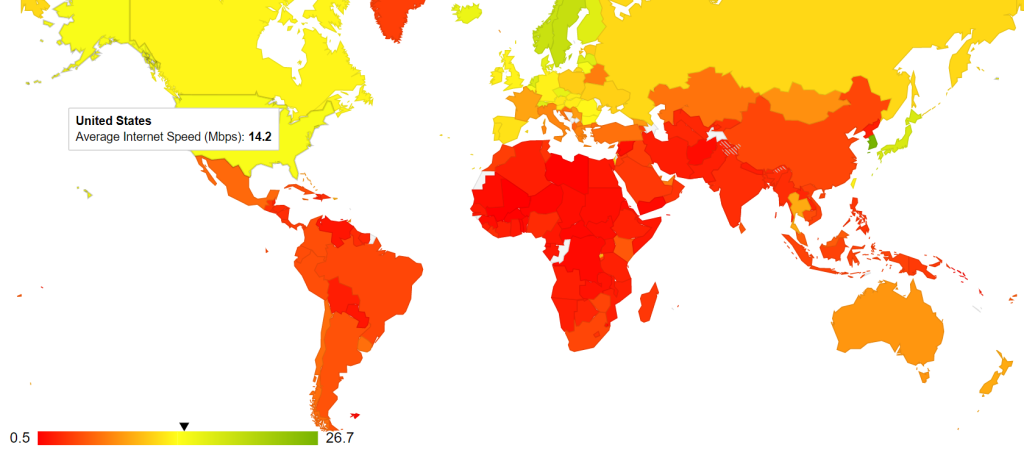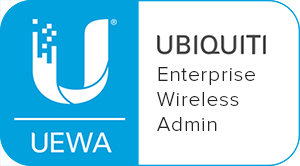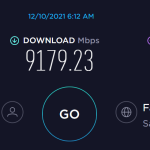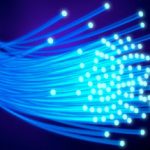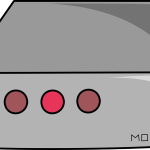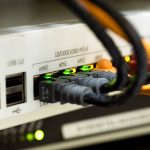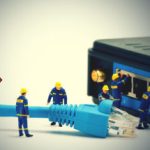Learn How Fiber Optic Cables Work
Fiber optic cables have transformed telecommunications and connectivity. Fiber technology is a game changer. Via fiber cables, signals can be sent across the world at the speed of light.
Ever wanted to learn how fiber cables work? No one does a better job of explaining how fiber cable works than Bill Hammack, The Engineer Guy. Below is Bill’s clear and concise video, which demonstrates the workings of fiber. Bill also explains how fiber cabling is used and what it can achieve.
Want to know why fiber is a better connectivity choice than other options? Below the video transcript, find further info on how fiber compares to other internet service technologies, what are the main benefits of fiber and where it is available.
Video: How Fiber Optic Cables Work & How Engineers Use Them To Send Messages
Video transcript: I find this a fascinating object. It’s a fiber optic cable for a stereo. If I shine this laser pointer down the cable, it guides the light out the other end. These cables are used to connect our world today and they’re capable of transmitting information across countries and oceans. But first, let me show you how fiber optic cables work.
I have a bucket that I modified with a window in front and on the other side, I put a stopper in this hole right here. I have a bottle of propylene glycol, with just a little bit of creamer in it. A ring stand and of course a laser pointer. Now, keep your eye on this plug when I turn out the lights. That’s wonderful. The light follows the liquid flow all the way to the bucket. Amazing. It does this because of total internal reflection. As the light enters the stream, it is reflected as soon as it hits the interface between here and liquid.
You can see here the first reflection and then the second and the third. This occurs because there’s a difference between the index refraction of the guide material, here propylene glycol, and the outside air in this case. Recall that anytime light strikes a surface, it can either be absorbed by the material, reflected from it or passed into and through it, the latter we call “refraction”. It’s easier to see from a top view. Reflection and refraction could happen at the same time. But if a light ray hits the surface at an angle greater than the critical angle, it will be completely reflected and not refracted.
For this propylene glycol and air system, as long as a beam hits the surface at an angle greater than 44.35 degrees, measured from the normal, it will propagate down the stream via total internal reflection. To create the same effect in an optical fiber, engineers create a core of glass, usually pure silicon dioxide and an outside layer called “cladding,” which they also typically make from silicon dioxide but with bits of boron or germanium to decrease its index of refraction.
A one percent difference is enough to make fiber optic cables work. To make such a long, thin piece of glass, engineers heat a large glass preform. Its center is the pure core glass and the outside the cladding. They then draw or pull a fiber by winding the melt on to a wheel at speeds up to 1600 meters per second. Typically these drawing towers are several stories tall. The height allows the fiber to cool before being wound onto a drum.
One of the greatest engineering achievements was the first ocean spanning fiber optic cable called TAT-8. It extended from Tuckerton, New Jersey, following the ocean floor over 3500 miles until branching out to Widemouth, England and Penmarch, France. Engineers designed the cable carefully to survive on the ocean floor. At its center lies the core. Less than a tenth of an inch in diameter, it contains six optical fibers wrapped around a central steel wire. They embedded this in an elastomer to cushion the fibers, surround it with steel strands and then sealed it inside a copper cylinder to protect it from water. The final cable was less than an inch in diameter, yet it could handle some 40,000 simultaneous phone calls.
The essence of how they send information through a fiber optic cable is very simple. I could have a pre-arranged signal with someone at the other end. Perhaps we will use Morse code and I just block the laser, so that the person at that end sees flashes that communicate a message. To transmit an analog signal, like voice from a phone call along the cable, engineers use Pulse Code Modulation. We take an analog signal and cut it up into sections and then approximate the wave’s loudness or amplitude as best we can.
We want to make this a digital signal, which means discrete values of loudness and not just any value. For example, I will use four bits, which means I have 16 possible values for the loudness. So the first four sections of the signal could be approximated by about 10, 12, 14 and 15. We then take each section and convert its amplitude to a series of ones and zeros. The first bar of value 10, when encoded, becomes one, zero, one, zero. We can do this for each section of the curve.
Now instead of looking at the green wave form or even the blue bars, we can think of the signal as a series of ones and zeros organized by time. It is that sequence that we send through a fiber optic cable of flash for one and nothing for a zero. Now of course, the exact method of encoding is known at the receiving end. So it is a trivial matter to decipher the message. Now you may be wondering how a laser pulse can travel nearly 4000 miles across the ocean. It doesn’t without some help because the light will escape from the sides of the fibers. Look back at our propylene stream.
Here’s how the light attenuates as it travels. You can see here a narrow beam in the bucket that broadens a bit when it enters the stream and then after the first bounce, the beam leaves even broader than it entered. That’s because the interface with the air is uneven and the rays that make up the beam strike at slightly different angles. When that beam makes its second reflection, those individual rays diverge even more. Until by the time it reaches the third bounce, many of the rays are no longer at the critical angle and can exit from the sides of the stream. Here it happens in a few inches but in fiber optic cables like TAT-8, the signal travels a stunning 50 kilometers before it needs to be amplified. Absolutely amazing. I’m Bill Hammack, the Engineer Guy.
Fiber Optic Internet Service Plan Considerations
When it comes to performance, Fastmetrics has explained and displayed how fiber optic internet is by far, the fastest internet service. In some cases, fiber optic internet plans can be up to 20 times the speed, or faster, than common broadband plans. In today’s society most businesses require the support of an internet service plan. To stay competitive, businesses must ensure that they have the best online capabilities. In this post, we look at the things that you should consider when looking into fiber optic internet plans from Fastmetrics, or any other fiber optic provider.
Fiber Optic Internet Plans Offer Increased Reliability
A fiber optic connection is less likely to be affected by service interruptions, due to its construction. As mentioned, engineers designed fiber optic cables such as TAT-8 to survive the pressures of the deep ocean. This is in order to be able to send signals across the world at the speed of light. Central steel wires are wrapped around optical fibers to protect them from breaking. In addition, for protection from water, engineers often seal optical fibers inside a copper tubing. Ironically, copper based internet connections are slower than fiber, but copper complements fiber in its construction.
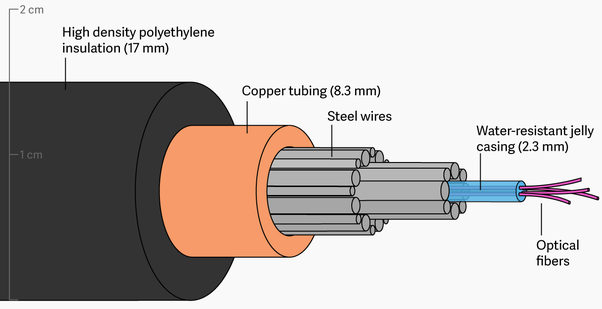
Anatomy of an undersea fiber optic cable
In a recent Nadex article on copper as a commodity, it was discussed how copper has helped initiate global changes through improving infrastructure. And this couldn’t be more true in the role it plays in protecting fiber cables, offering increased durability and reliability for telecommunications. Because of this durable combination of materials, fiber optic cables are less likely to be affected by power outages. Or, interrupted by external factors such as electrical equipment and lightning. With the internet being the key foundation of many businesses, it is important to consider how crucial it is to have a reliable internet connection.
Fiber Optic Internet Plans Provide Faster Speeds
The first thing that business owners need to decide on when getting a fiber optic plan is the level of speed required. Just how fast do you need your Internet to be? As an example, Fastmetrics offers symmetric connections from 100 x 100 Mbps, 250 x 250 Mbps, 500 x 500 Mbps, 1000 x 1000 Mbps (Gigabit) to the fastest – 10 Gbps x 10 Gbps fiber service, as well as dedicated Ethernet with similar gigabit per second speeds. Depending on the how much your company utilizes the internet in its day-to-day operations, will depend on the speed the business needs. Contact us if you would like an estimate on the fiber speed you might require. This is based on the number of employees at your business, as well as what you need internet service for. Tip: Get an estimate on what fiber optic speed is optimal, so you can get a plan that supports your needs.
Fiber Internet: Faster Uploads & Cloud Access
If your business needs to store or send huge amounts of data, you should consider a plan with faster upload speeds to services such as the cloud. Downloading and uploading large files or data can take a long time on a broadband connection. Tip: Choose a fiber optic plan with adequate upload speed. (All Fastmetrics fiber optic plans provide symmetric speeds for fast cloud access and downloads).
High Speed Symmetric Fiber Connectivity
Not all fiber optic connections are created equal. Some may offer fast download speeds, but what about upload speed? Symmetric connections are ideal when using VoIP or cloud PBX phone services. If your business needs an internet solution with consistent upload and download speed, you need a high speed symmetrical fiber optic connection. Symmetric connectivity prevents unnecessary delays in the downloading and uploading of data.
Fiber Optic Internet Installation Cost
One of the most important things to consider is how much it will cost to install a fiber optic internet connection. Without existing fiber lines, upgrading your internet service to fiber can be a large upfront investment for businesses. Some buildings contain existing fiber internet infrastructure, or are ‘lit’ with fiber already. Lit fiber buildings reduce initial end user outlays for fiber construction.
Information Age states that fiber optic technology has a long life cycle, due to its unmatched internet speeds and protective construction. The tech site states “telecom infrastructures go from one generation to next in a matter of months”. For those considering a fiber optic plan for their business, we hope that this has proved informative. In our post ‘10 Benefits to Fiber Optic Internet’, we provide a summary of the 10 major benefits of why we believe investing in fiber optic connectivity is a good idea.
How Has Fiber Optic Technology Revolutionized Telecommunications?
It has taken many years for fiber optics to be used to their full potential for telecommunication services. Considering fiber optic technology was first created more than 43 years ago, progress has been slow. This is ironic, seeing fiber offers end users access to data at the speed of light. For Internet and bandwidth purposes, fiber optic technology is still largely underutilized. Only a handful of service providers in select countries provide complete access to fiber based networks.
The Basics – How Are Fiber Optic Transmissions Sent?
In addition to the video above, which goes deep into understanding how fiber optic cables work, below are the 3 basic steps to how a transmission is sent via fiber;
- An optical signal is created using a transmitter
- The signal is relayed via the fiber, ensuring the signal is not distorted or diminished
- The signal is received and converted into an electrical signal
How Has Fiber Changed Telecommunications Today?
Since the establishment of the first fiber WAN in Essex in the U.K in 1978, fiber has slowly developed, grown and in some instances, completely replaced traditional copper based telecommunications services. Quite simply, fiber is a more efficient means of transmitting telecommunications signals (data and voice). Signals are sent by light over fibers made of glass, as opposed to copper wire.
Fiber vs. Copper vs. Cable – What Are The Advantages?
Fiber technology can be used for voice, (phones) and data (Internet and TV). It provides the following advantages over copper wire or cable based communications;
- Lower attenuation – the loss of intensity of any kind of physical property through a medium. (For example, the signal strength over the optical fiber).
- Less interference – electromagnetic interference effects an electrical circuit. This may interrupt, obstruct, degrade or limit a circuit’s performance. These effects may range from data limitation to total loss of data.
Disadvantages Of Fiber vs Copper vs Cable Based Internet
Previously, fiber optic infrastructure was not readily available in developed countries. Fiber was also costly and time consuming to install. Due to this, fiber was only used widely in long distance telephone communications, where it is used to it’s full capacity. By 2002, a worldwide network of more than 250,000 kilometers of fiber had been laid by the telecommunications industry, with a capacity of 2.56 Tb/s.
However, since the year 2000, the cost of fiber as an Internet service has been lowered greatly. In some cities in the United States, it is cheaper per subscriber, to roll out fiber to the home, than copper based service. This was evident through the Google Fiber program. The cost of fiber is even lower in countries such as the Netherlands and other developed Asian countries, such as South Korea and Japan. Click the link highlighted to see a complete comparison between DSL vs Fiber vs Cable.
Where Are Fiber Internet Networks Most Accessible?
In countries such as Japan, South Korea, Singapore and in many Scandinavian countries, fiber has largely replaced DSL as a broadband Internet service. Fiber infrastructure is extremely accessible in countries such as South Korea and also very affordable. This has led to countries such as Japan, Singapore and South Korea developing some of the fastest internet speeds in the world, along with many Scandinavian based countries.
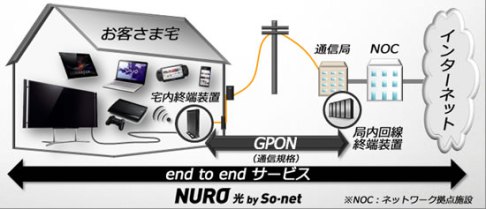
Japan’s So-net offers 2Gpbs fiber speed to the home
Where Is Fiber Most Available In The World?
Our worldwide internet speed study analysed data from global internet speeds between 2015 and May 2018. There was a strong correlation to higher average internet speeds in countries with more access to fiber based infrastructure and service.
Countries in green in the map have the highest average internet speeds. These include; most Scandinavian countries, South Korea, Japan and some European countries. (Full interactive map and tables of data are available via the link above). Coincidentally, many of these countries have a strong fiber internet presence. Whilst it is not always readily available in every country or area, fiber based internet and communications are certainly more effective in today’s Information Age, where the demand for consumers and businesses alike to receive information faster and in a variety of digital mediums, is in high demand.
About Fastmetrics, Inc. Building & Business ISP
Since 2002, Fastmetrics is the Bay Area’s only dedicated business ISP. We provide telecommunication services in California and the San Francisco Bay Area. Reliable service – backed by better live and local support. From install to 24-7 proactive monitoring, get treated like a VIP customer. Not a number by a faceless call center. We specialize in managed business internet and phones, dedicated high speed business fiber internet, business WiFi, SIP voice solutions / UCaaS and managed network services. We are a Microsoft and Cisco Meraki Partner. Our team are Certified Cisco Specialists, Ubiquiti Enterprise Wireless Accredited and Polycom Authorized Solution Advisors. We take care of your business network, so you can focus on growth.


